I would like to position a colorbar inside a scatter plot by specifying the position in data coordinates. Here is an example of how it works when specifying figure coordinates:
import numpy as np
import matplotlib.pyplot as plt
#Generate some random data:
a = -2
b = 2
x = (b - a) * np.random.random(50) + a
y = (b - a) * np.random.random(50) + a
z = (b) * np.random.random(50)
#Do a scatter plot
fig = plt.figure()
hdl = plt.scatter(x,y,s=20,c=z,marker='o',vmin=0,vmax=2)
ax = plt.gca()
ax.set_xlim([-2,2])
ax.set_ylim([-2,2])
#Specifying figure coordinates works fine:
fig_coord = [0.2,0.8,0.25,0.05]
cbar_ax = fig.add_axes(fig_coord)
clevs = [0, 1 , 2]
cb1 = plt.colorbar(hdl, cax=cbar_ax, orientation='horizontal', ticks=clevs)
plt.show()
...Ok, can't include an image of the plot here because I am lacking reputation. But the above code will give you an impression....
Now the question is, how could I position the colorbar at data coordinates, to appear at e.g.: left, bottom, width, height: -1.5, 1.5, 1, 0.25
I have experimented with a few things, like determining the axes position within the figure and transforming it to data coordinates but didn't succeed.
Many thanks for ideas or pointing me to already answered similar questions!
Here is what I did (not particularly beautiful but it helps). Thanks tcaswell !
#[lower left x, lower left y, upper right x, upper right y] of the desired colorbar:
dat_coord = [-1.5,1.5,-0.5,1.75]
#transform the two points from data coordinates to display coordinates:
tr1 = ax.transData.transform([(dat_coord[0],dat_coord[1]),(dat_coord[2],dat_coord[3])])
#create an inverse transversion from display to figure coordinates:
inv = fig.transFigure.inverted()
tr2 = inv.transform(tr1)
#left, bottom, width, height are obtained like this:
datco = [tr2[0,0], tr2[0,1], tr2[1,0]-tr2[0,0],tr2[1,1]-tr2[0,1]]
#and finally the new colorabar axes at the right position!
cbar_ax = fig.add_axes(datco)
#the rest stays the same:
clevs = [0, 1 , 2]
cb1 = plt.colorbar(hdl, cax=cbar_ax, orientation='horizontal', ticks=clevs)
plt.show()
